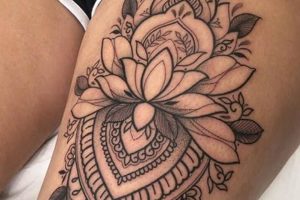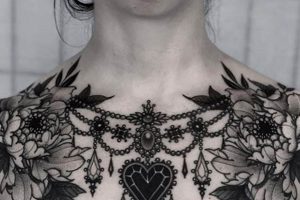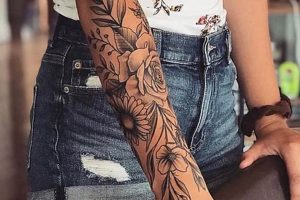Tattoos designed with an illusion of depth and realism, often incorporating shading, highlights, and intricate linework to create a three-dimensional effect, are increasingly popular aesthetic choices. These designs range from hyperrealistic objects, animals, and portraits to geometric patterns and abstract art that appear to interact with the wearer’s body contours. For example, a butterfly might seem to lift from the skin, or a flower to bloom in a lifelike manner.
This approach to body art allows for a greater level of detail and expressiveness, offering individuals a unique avenue for self-expression and artistic representation. Historically, tattooing has served various cultural and social purposes, from tribal affiliations and spiritual rituals to personal adornment. The contemporary emphasis on three-dimensional designs reflects an evolution in artistic techniques and technological advancements within the tattoo industry, providing an innovative way to personalize this ancient form of body modification. These designs offer a deeper connection to the art form, blurring the lines between body and canvas.
The following sections will explore various design inspirations, discuss the process of choosing a skilled artist, and offer essential aftercare tips to maintain the vibrancy and longevity of these intricate artworks.
Tips for Choosing 3D Tattoo Designs
Careful consideration is essential when selecting a three-dimensional tattoo design. These intricate artworks require a skilled artist and thoughtful planning to achieve the desired visual impact and longevity.
Tip 1: Research Experienced Artists: Locate artists specializing in three-dimensional tattooing. Examine portfolios for evidence of proficiency in realism, shading, and depth creation. An artist’s experience and style should align with the desired aesthetic.
Tip 2: Consider Body Placement: The body’s natural curves and contours influence the final appearance of a 3D tattoo. Discuss optimal placement with the chosen artist to maximize the illusion of depth and movement.
Tip 3: Choose Designs Wisely: Intricate details are crucial for achieving a convincing three-dimensional effect. Simple designs may not translate effectively into 3D. Explore designs specifically created for this style, focusing on elements that enhance the illusion of depth.
Tip 4: Plan for Multiple Sessions: Complex 3D tattoos often require multiple sessions to complete. Discuss a realistic timeline and commitment with the artist before commencing the process.
Tip 5: Understand Aftercare Procedures: Proper aftercare is crucial for preserving the vibrancy and longevity of a 3D tattoo. Follow the artist’s instructions diligently to minimize fading and ensure proper healing.
Tip 6: Budget Appropriately: Three-dimensional tattoos, due to their complexity and time investment, may be more expensive than traditional tattoos. Establish a realistic budget beforehand to avoid financial surprises.
Tip 7: Explore Different Styles: Research various 3D tattoo styles, such as biomechanical, realism, and geometric, to determine the best fit for individual preferences and desired aesthetics.
Careful planning and collaboration with a skilled artist ensure a successful and visually stunning three-dimensional tattoo. These considerations contribute significantly to the overall aesthetic impact and longevity of the artwork.
By adhering to these guidelines, individuals can approach this unique art form with informed decisions, leading to a positive and fulfilling tattoo experience.
1. Placement (Body Canvas)
Strategic placement significantly impacts the effectiveness of three-dimensional tattoo designs, particularly for women. The body’s natural curves and contours serve as a dynamic canvas, influencing how the illusion of depth and movement is perceived. A skilled artist considers anatomical features to maximize the three-dimensional effect, ensuring the design integrates seamlessly with the body’s form. For instance, a vine tattoo winding around the collarbone or a butterfly perched on the shoulder blade can appear strikingly lifelike due to the body’s underlying structure.
The interplay of design and placement creates a symbiotic relationship where each element enhances the other. A spider tattoo spanning across the hand can utilize the natural creases and joints to create a startlingly realistic effect, while a floral design flowing along the spine can emphasize the body’s elegant curvature. Choosing appropriate placement also affects the design’s visibility and how it interacts with clothing and movement. A discreet tattoo behind the ear can offer a subtle glimpse of artistry, whereas a larger piece on the thigh allows for a bolder statement. Careful consideration of these factors ensures the chosen design complements individual preferences and desired aesthetics.
Successful three-dimensional tattoos rely heavily on the thoughtful integration of design and body placement. Understanding this connection allows individuals to make informed decisions, maximizing the visual impact and personal significance of their chosen artwork. Effective placement choices transform the body into a living canvas, showcasing the artistry and depth of three-dimensional tattoo designs.
2. Realism (Lifelike Detail)
Realism serves as a cornerstone of successful three-dimensional tattoo designs, particularly when aiming for a lifelike representation. The meticulous attention to detail required to achieve photorealism elevates a tattoo from a simple image to an intricate work of art. Fine lines, subtle shading, and precise color gradients create the illusion of depth, texture, and form, making the design appear to interact with the skin’s surface. A portrait, for instance, can capture the subject’s unique features with startling accuracy, or a depiction of an animal can evoke a sense of movement and vitality through realistic fur or feather textures. This focus on lifelike detail is paramount in achieving a genuinely three-dimensional effect.
The pursuit of realism in 3D tattoos often demands specialized techniques and a higher level of skill from the artist. Understanding anatomical structures, light and shadow interplay, and the nuances of color theory are crucial for creating convincing illusions. This expertise translates into tattoos that possess a heightened sense of realism, capturing the essence of the subject matter with remarkable precision. Examples include a droplet of water appearing to glisten on the skin or a butterfly’s wings exhibiting the delicate translucence of nature. The commitment to realistic detail elevates the artistry of the tattoo, transforming it into a captivating visual experience.
Ultimately, the pursuit of realism in 3D tattooing represents a significant advancement in the art form. By pushing the boundaries of detail and precision, artists achieve breathtaking results that blur the line between body art and reality. This dedication to lifelike representation not only enhances the aesthetic appeal of the tattoo but also strengthens its personal meaning for the wearer. The intricate details embedded within the design become a testament to the artist’s skill and the individual’s commitment to expressing themselves through a powerful and enduring art form.
3. Geometry (Abstract Depth)
Geometric patterns offer a unique approach to three-dimensional tattoo design, particularly for women seeking abstract representations of depth and dimension. Unlike realistic depictions, geometric 3D tattoos rely on optical illusions and carefully calculated linework to create the impression of depth on the skin’s surface. Interlocking shapes, tessellations, and strategically placed shading can trick the eye into perceiving a three-dimensional form where none physically exists. This approach allows for a high degree of creativity and customization, as the patterns can be tailored to individual preferences and body contours. A geometric sleeve, for instance, can incorporate spiraling lines and shaded cubes to create a mesmerizing illusion of depth, while a smaller piece on the wrist might feature interlocking triangles that appear to rise from the skin.
The effectiveness of geometric 3D tattoos hinges on the artist’s understanding of perspective, spatial relationships, and the interplay of light and shadow. Precise execution is crucial for achieving the desired optical illusion. A seemingly simple design, such as a series of concentric circles, can be transformed into a complex three-dimensional sphere through subtle variations in line weight and shading. Similarly, strategically placed lines can create the impression of folds, ridges, or depressions, adding a tactile dimension to the otherwise flat surface of the skin. This interplay of precision and artistry allows for a wide range of expressive possibilities, from intricate mandalas that appear to radiate outwards to minimalist geometric patterns that evoke a sense of subtle depth and movement. Examples include a torus knot appearing to intertwine around the forearm or a Metatron’s Cube creating a multi-dimensional effect on the back.
Geometric abstraction in 3D tattooing provides a compelling alternative to realistic depictions, offering a unique blend of artistry and optical illusion. The ability to manipulate depth and dimension through linework and shading opens up exciting possibilities for self-expression. Careful consideration of pattern, placement, and the artist’s skill ensures a successful and visually captivating three-dimensional geometric tattoo. This approach empowers individuals to embrace a more abstract form of body art, celebrating the interplay of geometry, perception, and personal aesthetics.
4. Size and Scale (Visual Impact)
Size and scale play a crucial role in the overall impact of three-dimensional tattoo designs, particularly for women. The dimensions of a tattoo significantly influence its visibility, the level of detail achievable, and how it interacts with the body’s contours. Careful consideration of size and scale ensures the chosen design aligns with individual preferences and aesthetic goals, maximizing its visual impact.
- Proportion and Body Area:
The size of a 3D tattoo should be proportional to the body area it adorns. A large, intricate design might overwhelm a smaller area like the wrist, while a small, simplistic design might get lost on a larger area like the back. Proper proportion ensures the design complements the body’s natural curves and proportions, enhancing its visual appeal. A sprawling landscape scene, for example, would be well-suited to the back or thigh, whereas a delicate hummingbird might be more appropriately scaled for placement behind the ear.
- Detail and Complexity:
The scale of a tattoo directly impacts the level of detail an artist can achieve. Intricate designs with fine lines and subtle shading require a larger canvas to be fully realized. Conversely, smaller tattoos may necessitate a simplification of the design to maintain clarity and prevent blurring over time. A highly detailed biomechanical design, for example, would require sufficient space to showcase its intricate gears and pistons, whereas a smaller, stylized flower might rely on bolder lines and simpler shading.
- Visual Impact and Distance:
The intended visual impact of a 3D tattoo influences its size and scale. A large, bold design immediately draws the eye and makes a strong statement, while a smaller, more discreet design offers a subtle touch of artistry. Consideration should also be given to how the tattoo will appear from various distances. A large-scale piece on the back might be fully appreciated only from a distance, whereas a smaller piece on the wrist can be admired up close, revealing its intricate details.
- Longevity and Detail Retention:
Size and scale influence a tattoo’s longevity and how well it retains detail over time. Larger tattoos generally hold their detail better than smaller ones, as the lines and shading have more room to fade without losing their overall definition. This is particularly important for intricate 3D designs, where the illusion of depth relies on precise lines and subtle gradations. A large-scale geometric pattern, for instance, is more likely to retain its sharp lines and intricate shading over time compared to a smaller, highly detailed portrait.
Understanding the interplay between size, scale, and visual impact allows individuals to make informed decisions about their 3D tattoo designs. Careful consideration of these factors, in conjunction with body placement and design complexity, ensures a harmonious and visually striking result. By thoughtfully balancing these elements, women can achieve 3D tattoos that not only enhance their personal aesthetic but also stand the test of time, preserving their intricate artistry and intended impact.
5. Color and Shading (Enhanced Dimension)
Color and shading are fundamental components of three-dimensional tattoo designs, especially for women seeking to enhance the depth and realism of their body art. Skilled manipulation of these elements creates powerful visual illusions, transforming flat surfaces into seemingly textured and contoured forms. Color selection contributes significantly to the overall aesthetic and symbolic meaning of the tattoo. Vibrant hues can evoke a sense of energy and dynamism, while muted tones suggest a more understated elegance. Strategic color placement can also be used to highlight specific areas of the design, further enhancing the illusion of depth and dimension. For instance, a butterfly tattoo might employ vibrant blues and purples on the wings, contrasted with darker shades along the body to create a sense of volume and realism. Similarly, a floral design could utilize a gradient of colors from light to dark to mimic the natural shading and curvature of petals.
Shading is equally crucial in achieving a convincing three-dimensional effect. Through careful manipulation of light and shadow, artists create the illusion of depth, texture, and form. Gradual transitions from dark to light mimic the way light naturally interacts with three-dimensional objects, creating a sense of realism and dimensionality. This technique can be applied to a wide range of designs, from realistic portraits to abstract geometric patterns. A portrait tattoo, for example, might utilize subtle shading to define facial features and create a sense of depth, while a geometric design could employ shading to make shapes appear to recede or protrude from the skin. The interplay of color and shading is essential for creating a visually captivating and convincing three-dimensional effect. A skilled artist understands how to balance these elements to achieve the desired aesthetic and maximize the illusion of depth. Realistic depictions of water droplets, for example, rely heavily on highlights and shadows to create the illusion of transparency and reflectivity.
Mastery of color and shading techniques allows artists to elevate tattoo designs to a higher level of artistry and realism. These elements are crucial for achieving the convincing illusions of depth and dimension that characterize successful three-dimensional tattoos. Understanding the interplay of color, shading, and light allows for informed design choices and enhances appreciation for the artistry involved in creating these intricate and visually stunning works of body art. Furthermore, the longevity and vibrancy of a 3D tattoo depend heavily on the quality of the inks used and the artist’s skill in applying them. Choosing high-quality pigments and an experienced artist are essential for ensuring the long-term vibrancy and clarity of the design, preserving its three-dimensional effect over time. This investment not only enhances the immediate aesthetic appeal but also safeguards the artistic integrity of the tattoo for years to come.
6. Artist Selection (Expertise Matters)
Selecting a qualified artist is paramount when considering three-dimensional tattoo designs, especially for women. The technical demands of creating convincing illusions of depth and realism require a high level of skill and experience. A skilled artist possesses a deep understanding of anatomy, perspective, light, and shadow, crucial for achieving the desired three-dimensional effect. Their expertise extends beyond technical proficiency to include artistic vision and the ability to translate a client’s concept into a visually stunning and technically sound tattoo. An artist specializing in realism, for example, might excel at creating lifelike portraits that appear to emerge from the skin, while another specializing in geometric patterns might master the intricate linework and shading necessary to create optical illusions of depth and dimension. Choosing an artist with a proven track record in 3D tattooing significantly impacts the final result, ensuring the design is executed with precision and artistry.
Thorough research and careful consideration are essential when selecting a 3D tattoo artist. Reviewing portfolios, seeking recommendations, and consulting with potential artists are crucial steps in the decision-making process. A portfolio showcases an artist’s style, technical capabilities, and experience with various 3D design elements. Client testimonials and recommendations offer valuable insights into an artist’s professionalism, communication style, and ability to meet client expectations. Direct consultation allows for a discussion of design ideas, technical considerations, and the artist’s approach to achieving the desired three-dimensional effect. For instance, an artist specializing in biomechanical tattoos might discuss the intricacies of incorporating realistic gears and pistons into the design, while an artist specializing in surrealism might explore how to create dreamlike landscapes that appear to transcend the boundaries of the skin. This collaborative approach ensures a clear understanding between the client and the artist, paving the way for a successful and satisfying tattoo experience.
Artist selection directly impacts the quality, longevity, and overall aesthetic of a 3D tattoo. Investing time and effort in finding a qualified and experienced artist is crucial for achieving the desired outcome and ensuring a positive experience. This careful selection process not only safeguards the artistic integrity of the tattoo but also protects the client’s health and well-being. A reputable artist adheres to strict hygiene standards and utilizes professional-grade equipment, minimizing the risk of complications and ensuring the tattoo heals properly. Ultimately, choosing the right artist is an investment in a piece of art that will adorn the body for years to come, a testament to the artist’s skill and the client’s personal expression.
7. Aftercare (Preserving Artwork)
Diligent aftercare is essential for preserving the intricate detail and vibrancy inherent in three-dimensional tattoo designs, especially for women. These designs, characterized by their interplay of light, shadow, and color gradients, require specific care to maintain their longevity and prevent premature fading or blurring. Neglecting proper aftercare can compromise the visual impact of the tattoo, diminishing the three-dimensional effect and potentially leading to costly and time-consuming touch-ups. The raised, textured nature of some 3D designs further necessitates meticulous aftercare to prevent infection and ensure proper healing, preserving the intended aesthetic and structural integrity of the artwork. For example, a 3D floral tattoo, with its delicate interplay of colors and shading, requires careful cleaning and moisturizing to prevent the colors from muddying and the details from becoming indistinct. Similarly, a geometric 3D design, reliant on precise lines and sharp contrasts, demands meticulous attention to prevent ink bleeding or blurring, which could compromise the intended optical illusion.
Practical aftercare involves several key steps. Keeping the tattoo clean and moisturized is paramount during the healing process. This includes gentle washing with unscented soap and applying a fragrance-free moisturizer to prevent excessive dryness and scabbing. Protecting the tattoo from sun exposure is crucial, as UV rays can significantly fade ink, particularly the subtle color gradations essential for three-dimensional effects. Using a high-SPF sunscreen, even after the tattoo has healed, helps maintain vibrancy and prevent premature aging of the ink. Avoiding harsh chemicals, abrasive fabrics, and excessive soaking or scrubbing during the healing period is also critical. These precautions protect the delicate skin and allow the ink to settle properly, preserving the intricate details and overall aesthetic of the three-dimensional design. For instance, prolonged exposure to chlorinated water can bleach tattoo ink, diminishing the vibrancy of a 3D butterfly’s wings or dulling the metallic sheen of a biomechanical design. Similarly, picking at scabs can disrupt the ink’s placement, leading to uneven coloration and a loss of detail, particularly in highly intricate 3D designs.
Appropriate aftercare is not merely a recommendation; it is an integral part of the 3D tattoo process, directly impacting the longevity and visual integrity of the artwork. Understanding the specific aftercare needs of three-dimensional tattoos ensures these intricate designs retain their depth, vibrancy, and artistic impact for years to come. By adhering to best practices and seeking professional guidance when necessary, individuals can protect their investment and enjoy a vibrant, lasting piece of three-dimensional body art. Failure to properly care for a 3D tattoo can not only diminish its aesthetic appeal but also increase the risk of complications such as infection or scarring, potentially necessitating corrective procedures that can further compromise the design’s integrity. Therefore, a proactive and informed approach to aftercare is crucial for preserving the beauty and longevity of these intricate and captivating works of art.
Frequently Asked Questions
This section addresses common inquiries regarding three-dimensional tattoo designs for women, offering factual information and practical guidance.
Question 1: How does the healing process for a 3D tattoo differ from a traditional tattoo?
Three-dimensional tattoos, due to their intricate detail and often raised texture, may require a slightly longer healing period and more meticulous aftercare. Strict adherence to aftercare instructions provided by the artist is crucial for optimal healing and preservation of the three-dimensional effect.
Question 2: Are 3D tattoos more painful than traditional tattoos?
Pain levels vary based on individual pain tolerance, tattoo placement, and design complexity. Three-dimensional designs, particularly those involving intricate detail or larger coverage areas, may require longer sessions, potentially increasing overall discomfort. Consulting with the chosen artist regarding pain management strategies is advisable.
Question 3: How long do 3D tattoos typically last?
Longevity depends on factors such as ink quality, aftercare practices, sun exposure, and individual skin characteristics. Proper aftercare, including sun protection, significantly extends the vibrancy and clarity of three-dimensional tattoos, preserving their intricate detail for many years. Periodic touch-ups might be necessary to maintain optimal appearance over time.
Question 4: Can any design be translated into a 3D tattoo?
While many designs can be adapted for a three-dimensional effect, certain designs lend themselves better to this style. Intricate patterns, realistic depictions, and designs incorporating elements of light and shadow translate effectively into 3D. Consulting with an experienced 3D tattoo artist helps determine design suitability and feasibility.
Question 5: How much do 3D tattoos typically cost?
Cost varies based on factors such as design complexity, size, artist experience, and geographic location. Three-dimensional tattoos, due to their technical demands and time investment, often have a higher price point than traditional tattoos. Obtaining a detailed quote from the chosen artist before commencing the process is recommended.
Question 6: Can 3D tattoos be removed or covered up?
Removal or cover-up options exist for 3D tattoos, similar to traditional tattoos. However, the complexity of these designs might present additional challenges for removal or cover-up procedures. Consulting with a qualified laser tattoo removal specialist or a skilled cover-up artist is crucial to explore available options and potential limitations.
Careful consideration of these frequently asked questions ensures informed decision-making when exploring three-dimensional tattoo designs. Thorough research and consultation with experienced professionals contribute to a positive and successful tattoo experience.
The subsequent section provides a visual gallery of diverse three-dimensional tattoo designs for women, offering further inspiration and aesthetic exploration.
Conclusion
Three-dimensional tattoo designs offer women a powerful medium for self-expression, pushing the boundaries of traditional tattoo artistry. Careful consideration of placement, realism, geometry, size and scale, color and shading, artist selection, and aftercare practices ensures successful execution and longevity of these intricate artworks. Understanding these key elements empowers informed decisions, resulting in tattoos that seamlessly integrate with the body’s contours, creating visually captivating and deeply personal statements.
As tattoo artistry continues to evolve, exploration of three-dimensional designs presents exciting possibilities for personal expression and aesthetic innovation. The fusion of technical skill, artistic vision, and individual narratives ensures these dynamic artworks remain a compelling choice for those seeking to transform their bodies into living canvases. The commitment to meticulous planning and execution elevates three-dimensional tattoos beyond mere adornment, solidifying their status as a powerful and enduring art form.







